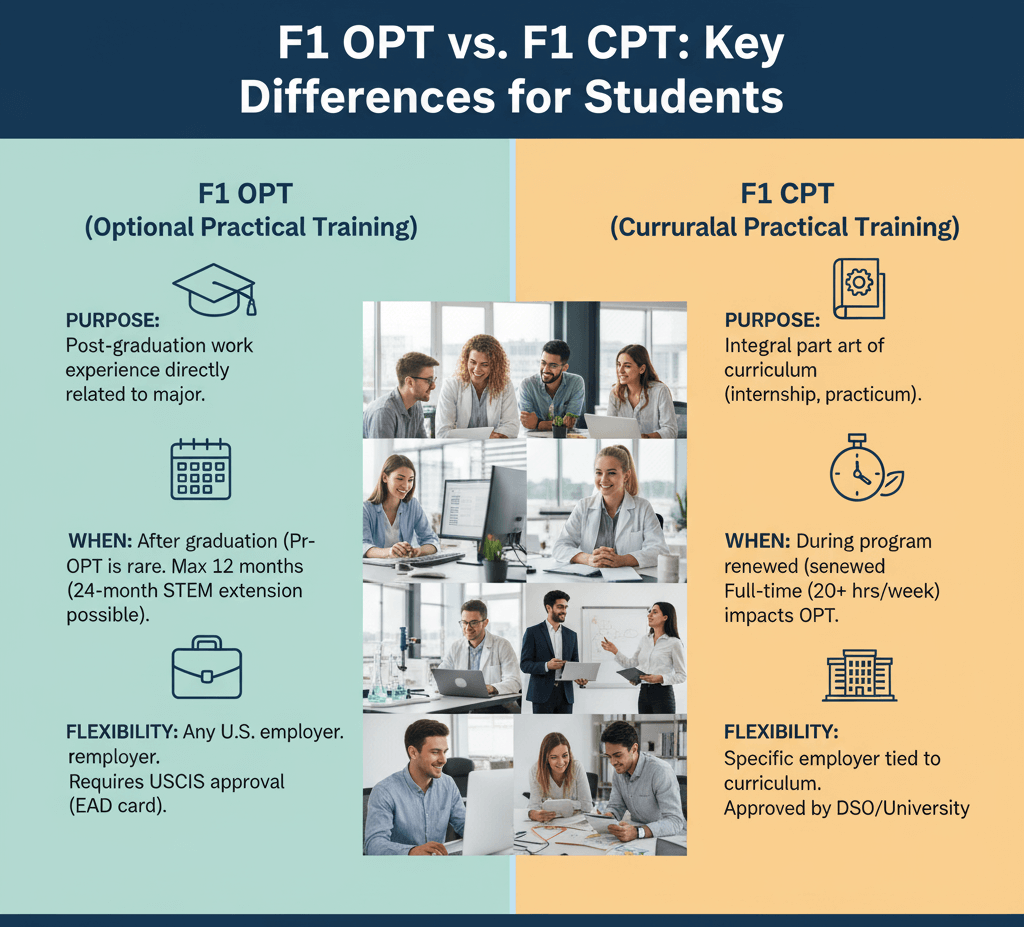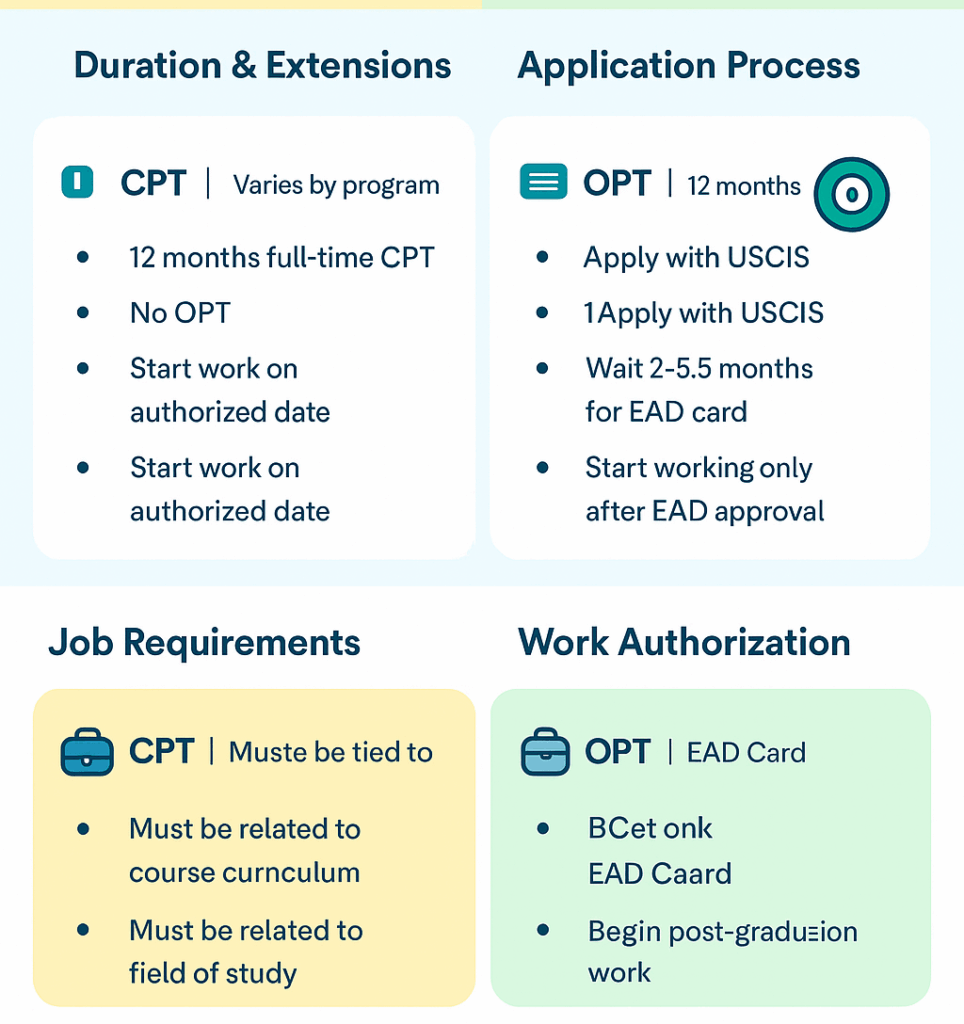
International students in the U.S. often hear about Curricular Practical Training (CPT) and Optional Practical Training (OPT) during their academic journey. Both options are designed to provide practical work experience in a student’s field of study, but they differ in terms of eligibility, process, and duration. For F-1 visa holders, understanding these differences is critical to maintaining legal status and maximizing career opportunities.
What is F1 CPT?
Curricular Practical Training (CPT) allows F-1 students to gain work experience during their studies through internships, cooperative programs, or training related to their degree. Some universities also provide Day 1 CPT, which means students can begin practical training from the very start of their academic program if it is a required part of the curriculum. CPT must be authorized by the university’s Designated School Official (DSO) before employment begins.
What is F1 OPT?
Optional Practical Training (OPT) provides F-1 students with temporary work authorization, usually after completing their degree. OPT requires approval from U.S. Citizenship and Immigration Services (USCIS), and students must wait for their Employment Authorization Document (EAD) before starting work. OPT gives students up to 12 months of employment authorization, with an additional 24-month STEM extension available for certain science, technology, engineering, and mathematics graduates.
Duration and Extensions
- CPT Duration: The length of CPT depends on the academic program and university policies. It can be part-time (up to 20 hours per week) or full-time. However, if a student uses 12 months of full-time CPT, they lose eligibility for OPT.
- OPT Duration: Students get 12 months of OPT per education level. For example, a student can use OPT after a bachelor’s degree and again after a master’s degree. STEM graduates may apply for a 24-month OPT extension, making the total up to 36 months.
Application Process
- CPT: Apply through your university’s international student office. The DSO reviews the request, ensures the job is related to your degree, and issues a new I-20 with CPT authorization. Approval is usually quick.
- OPT: Apply directly to USCIS by filing Form I-765 (Application for Employment Authorization). The process can take 2–5 months, and students cannot start working until they receive the EAD card. Timing the application correctly is crucial.
Job Requirements
- CPT Jobs: Must be directly related to your field of study and often part of your curriculum (such as internships or cooperative education). Some schools make internships mandatory, which is why Day 1 CPT is possible.
- OPT Jobs: Must also be directly related to your degree, but OPT offers more flexibility. The job can be part-time or full-time, paid or unpaid, as long as it aligns with your academic field.
Work Authorization
- CPT Work Authorization: Granted by the university through the updated I-20. Students can only work for the employer and duration specified on the CPT authorization.
- OPT Work Authorization: Granted by USCIS through the EAD card. Students can work for any employer in their field of study and even change employers, provided they update their SEVIS record.

Step-by-Step Timeline: When to Apply for CPT vs. OPT
CPT (During Studies)
- Enroll in an SEVP-certified university.
- Complete at least one academic year (unless on Day 1 CPT).
- Secure an internship or training related to your field of study.
- Apply through your university’s DSO for CPT approval.
- Receive a new I-20 with CPT authorization.
- Start working only after the CPT I-20 start date.
OPT (After Graduation)
- Maintain valid F-1 status during your degree.
- Choose between Pre-Completion OPT (during studies) or Post-Completion OPT (after graduation).
- Apply to USCIS with Form I-765 (can apply up to 90 days before graduation, but no later than 60 days after).
- Wait for OPT approval and your EAD card (2–5 months processing time).
- Begin working only after receiving the EAD card.
- If eligible, apply for a STEM extension before your first OPT expires.
Key Differences at a Glance
| Feature | CPT (Curricular Practical Training) | OPT (Optional Practical Training) |
| When You Can Use It | During studies (sometimes Day 1) | Usually after graduation |
| Approval Authority | University DSO | USCIS |
| Work Start Time | After receiving CPT I-20 | After receiving EAD card |
| Duration | Varies; depends on program | 12 months (+24 months STEM) |
| Job Requirement | Must be part of curriculum | Must be related to major |
| Work Authorization | CPT I-20 from university | EAD card from USCIS |
Frequently Asked Questions (Q&A)
Q1: Can I use both CPT and OPT?
Yes, but using 12 months of full-time CPT eliminates eligibility for OPT. Part-time CPT does not affect OPT.
Q2: How do I apply for CPT?
Through your university’s international student office. The DSO will authorize it and issue a new I-20.
Q3: How long does it take to get OPT approval?
It usually takes 2–5 months. You cannot work until you receive the EAD card.
Q4: Can OPT be extended?
Yes. STEM graduates can apply for a 24-month extension, giving them up to 36 months of OPT.
Q5: Which option is better: CPT or OPT?
It depends on your situation. CPT is best for gaining experience while studying, while OPT is ideal for full-time employment after graduation. Many students use both strategically to maximize work opportunities.
Both F1 CPT and F1 OPT are valuable opportunities for international students, but they serve different purposes. CPT is tied closely to the curriculum and can even start from Day 1 at some schools, while OPT is a post-graduation work option requiring USCIS approval. By understanding their duration, application process, job requirements, and work authorization differences, students can plan their academic and career path wisely without risking their visa status.
